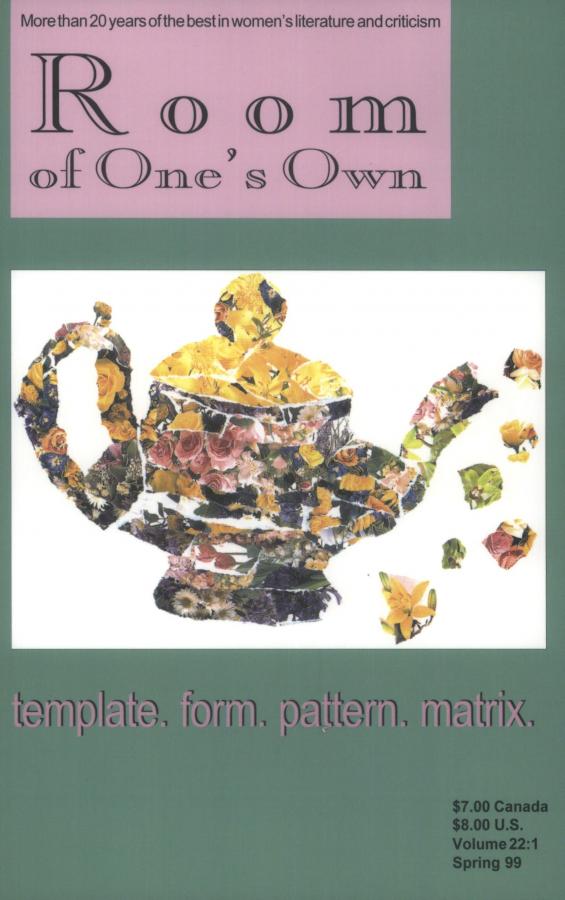Template. Form. Pattern. Matrix. | 22.1
1999
Digital only; out of stock in print.
Template. Form. Pattern. Matrix. The original, from which others are reproduced, copied or formed.
Many of the pieces in this issue of Room of One’s Own deal with the concept of the matrix. It has been at the heart of many of our previous issues, and I imagine that future issues will explore it as well. It’s a topic of endless interest to us—especially those of us who are writers and artists— whether it is a conscious interest or not. Are we the reproduction, or the original?
It seems to me that, for many of us, it is only when we engage in the process of exploring this question that we make the shift from being the reproduction to being the original. This is the point at which we say, this is how it is, this is how I am. It is part ofthe process of being creative.
The poets in this issue all have their own take on the matrix. Judith Milstein Katz writes about hiding cerebral palsy: “From habit, and childfear,/ I lie until my forties.” Eva Tihanyi says, of being a daughter, “As for her,/ she’s given up the role,/ would rather be running.” It is at the heart of Bernadette L. Wagner’s Clothesline Chat, Joan Hoekstra’s Margaret Mitchell’s Daughters, Rita Taryan’s three poems about a sick child, and Heather MacLeod’s fine poem, silversmith. Sina Queyras’s sequence of poems explores it from a different angle. Linda Frank’s imagery, “settle to the haunt of the loon/swim the reclining path of the sun” and Julie Lechevsky’s way with language, “We will have our wedge ofsoft things,”remind us that the process of making the big choices is made simpler by being constantly aware ofthe smaller choices available to us.
And what about the fiction in this issue? Diane Bracuk’s Valentine and Martha Kilgore-Rice’s Furthermore, She had Never Read Anais Nin, Dana Bath’s just ahead of us in line, Mary Toohey’s Smoke and Beth Goobie’s Edge-walker all strong engaging stories, revealing to us female characters who make choices over and over again as to how they will be in the world.
And Jessica Harris’s essay Gothic has the final word. She tells us, in discussing the dangerous world of the imagination,“These women understood that the imagination is a place of longings and questionings, of dissatisfaction, of visions of the ways that things could be different. It was the place where they could envision possibilities that were deemed unacceptable by the rest of the world. Once this world has been explored and these visions admitted to, contentment with the world the way it was would be impossible. Eventual challenge, and upheaval, and change become inevitable.” This is the point from which we start to move from being the reproduction to being the original.
Welcome to another issue of Room of One’s Own. Template. Form. Pattern. Matrix.

$10.00
Additional information
| Delivery | Canada, USA, International, Digital |
|---|
In this issue: Julianna van Amerongen, Virginia Aulin, Dana Bath, Diane Bracuk, Linda Frank, Beth Goobie, Jessica Harris, Joan Hoekstra, Martha Kilgore-Rice, Julie Lechevsky, Heather MacLeod, Judith Milstein Katz, Sina Queyras, Rita Taryan, Eva Tihanyi, Mary Toohey, Bernadette L. Wagner